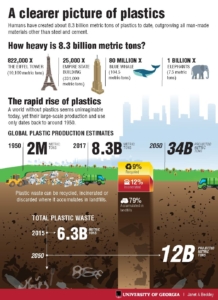Millions of people around the world have been attached to their screens viewing the BBC documentary “Blue Planet 2” narrated by Sir David Attenborough. This documentary has reminded the public that marine life is currently in danger. According to The Guardian, more than eight million tonnes of plastic are thrown away each year and washed away into the sea. Plastic has a negative imprint on animal’s health; they think it as an edible substance. Increasingly it is possible for animals to choke or be strangled in plastic, like nets, bags or containers. When plastic gradual breaks down it becomes tiny micro plastic. These parts end up in the animal’s tissue and may affect humans as well when we consume marine animals or fish. These are only a few examples; plastic on land pollute our ecosystems, landscapes and rivers. “Blue Planet II” is a great reminder for us of how proliferating plastic pollution is on our planet. The estimation is that by 2050 there will be more plastic in the oceans than the weight of all fish together. Plastic pollution is a problem where measures must be undertaken before it is too late.

An important way to address this problem is education and action with children and youth. Research shows that when younger children were engaged in environmental education, they were less likely to demonstrate harmful behaviors towards the environment and become agents of positive change. They are also more likely to be involved in promoting the environmentally responsible behaviors of others. It is important to keep in mind that content, knowledge, and skills are not enough. These are more effective in influencing attitude changes when you add action to the program.
In my school in Kyiv, there is a humanitarian and environmental student group called ESI (Environmental and Service Initiative) which takes action by recycling waste, batteries, paper, and plastic. ESI has also recently organized the second annual “Trashion” Show during Earth Day and is currently engaged in making a vegetable and herbs garden with an outdoor classroom. These environmental actions are aimed at drawing attention within the school community regarding environmental issues.
Another way to deal with this issue is to increase environmental awareness concerning the harm of plastics. Environmental education raises children’s awareness of the environment and provides learning experiences through which they obtain knowledge, values, and skills to solve environmental problems now and in the future. Ideally, environmental education should be a continuous learning process that is integrated into the curriculum and begins when children are very young. Why begin environmental education so young if it takes years before the children grow up and become policy makers? When they are young, children can be more easily taught to have respect for the environment and it becomes a practice and habit which students are more likely to continue later on in their life. This mind set can shape and form their actions throughout life. A school is an ideal environment to set an example of recycling and environmental practice. As they become involved in environmental issues that relate to their immediate environment and the world beyond through school projects, they will not only learn and retain the information, they will also internalize the values associated with caring for the environment and conserving our resources. Another side benefit is that children have tremendous influence over their parents and can use the knowledge and skills learned through their participation in learning experiences to influence the attitudes and behaviors of their parents and other community members. Such child influence can be seen in my school when it comes to building awareness. Elementary teachers mentioned that because of the ESI recycling program, the children tell their parents that they need to do recycling at home. Several families have adopted a recycling program at home.
Here are a few concrete actions people could easily undertake on their own.
1. Do not buying plastic bottles but keep and use your own reusable drinking bottle.
2. Bring grocery bags to the shop instead of buying plastic bags.
3. Recycle your waste and bring it to a recycle collection point (there are many recycle points in Kyiv).
4. Do not accept or use single-use plastics, like spoons, knives, plates, straws, etc. Try to avoid this as much as you can.
Ideally, education leads to action. These first steps are a good beginning but we should continue to take action and develop new solutions. The young generation should be a part of this process, as they are the individuals who will take responsibility for preserving our Earth together.
By: Cybele Galay
Student,

